Introduction
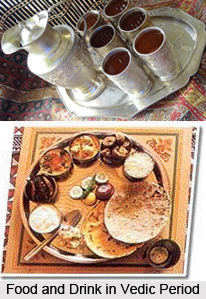 Food in Vedic period begins with cereals like rice and barley which formed a major part of food in Vedic period. The Vedic literature throws considerable light on the food and drink habits of the people of the ancient India. Among the food grains, the Rig Veda repeatedly mentions barley, particularly fried barley. These were used in preparing sweet cakes which were either dipped in ghee before eating or consumed with "Somarasa" prepared with curd and butter which formed a major part of Vedic meal. Along with this the food of the Vedic period include large varieties of pulses, dairy products, meat, salts and spices, sweets and a variety of beverages which reflect the culture of Vedic period that came through the food habits of the Indian people.
Food in Vedic period begins with cereals like rice and barley which formed a major part of food in Vedic period. The Vedic literature throws considerable light on the food and drink habits of the people of the ancient India. Among the food grains, the Rig Veda repeatedly mentions barley, particularly fried barley. These were used in preparing sweet cakes which were either dipped in ghee before eating or consumed with "Somarasa" prepared with curd and butter which formed a major part of Vedic meal. Along with this the food of the Vedic period include large varieties of pulses, dairy products, meat, salts and spices, sweets and a variety of beverages which reflect the culture of Vedic period that came through the food habits of the Indian people.
Different Food Products in Vedic Period
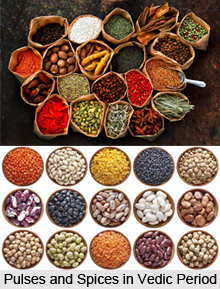 Food in Vedic period included both vegetarian as well as non-vegetarian food items. The agrarian culture of Indian society allowed the Vedic people to cultivate a number of pulses like masura, masa, arahar, grams, peas and kulattha along with rice, wheat and barley form a major part of food in Vedic society. Among the dairy products, milk formed the principle ingredient of the Vedic society. Generally cow"s milk was consumed after boiling it. Milk was used for preparing some more items in which milk was milked with either with soma juice or messed with grains to create a whole meal of barley. Along with cow"s milk of buffaloes was also included which has been mentioned in Rig Veda and post- Rig Veda period. Largely milk was taken in the form of fresh milk, or boiled milk or with cream. Along with various forms of milk goat milk also formed a major part of Indian society that is mentioned in the Rig Vedas.
Food in Vedic period included both vegetarian as well as non-vegetarian food items. The agrarian culture of Indian society allowed the Vedic people to cultivate a number of pulses like masura, masa, arahar, grams, peas and kulattha along with rice, wheat and barley form a major part of food in Vedic society. Among the dairy products, milk formed the principle ingredient of the Vedic society. Generally cow"s milk was consumed after boiling it. Milk was used for preparing some more items in which milk was milked with either with soma juice or messed with grains to create a whole meal of barley. Along with cow"s milk of buffaloes was also included which has been mentioned in Rig Veda and post- Rig Veda period. Largely milk was taken in the form of fresh milk, or boiled milk or with cream. Along with various forms of milk goat milk also formed a major part of Indian society that is mentioned in the Rig Vedas.
Food in Vedic period along with these included some non vegetarian items like meat. Rig Veda mentions that whatever is offered as sacrifice including animals shall be consumed by the priest. This allows the people of Vedic age to take animal flesh as food items. Along with such food items the food of Vedic period is prepared with large variety of salts and spices such as brassica, turmeric and long pepper which are frequently mentioned in Rig Veda and other Vedic literature. Within the fruits and vegetables the Rig Vedic civilization saw distinctive use of olives and Kharitira, while mango and amlaka has been frequently referred in Vedic literature. Vegetables like cucumber and lotus stalk were used as major food items. Other food items include edible roots of the lotus and bottle gourd and saphaka which have been used as food items.
Cooking in Vedic Period
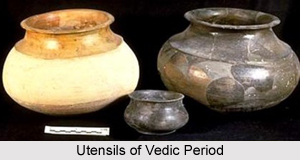 Development of Cooking in Vedic period usually reflects the domestic method of preparing food. These include methods like cleaning food grains with a sieve and grinding them which were known from earlier days. In the Vedas, it elaborately explains the vastness of Vedic cooking and its richness with close proximity to the forces of nature.
Development of Cooking in Vedic period usually reflects the domestic method of preparing food. These include methods like cleaning food grains with a sieve and grinding them which were known from earlier days. In the Vedas, it elaborately explains the vastness of Vedic cooking and its richness with close proximity to the forces of nature.
Vedic cooking introduced a number of items which were not known in the past. The preparations of such new items reflect a high level of development that pulls the society from rural ruins to urban superiority. Vedic cooking also includes preparation of meat which was not only roasted but also cooked in the form of soup that was cooked with rice. Vedic cooking not only includes the art of cooking and the types of utensils used by them but also the rules and etiquettes which were followed by the people of Vedic period.
Utensils and Implements of Vedic Period
Development of Cooking in Vedic period also included various kinds of utensils and implements that were included for cooking and serving the food. Some of these implements were made up of clay, wood and stone while other implements were made up of metals. Leather vessels were used to store liquid products.
Etiquettes of Vedic Period
In terms of etiquettes, Vedic literature emphasised and narrated a wide description to be followed during preparation of food and serving it to the Aryans. According to the "Ksema-kuntuhala", a Vedic cookbook from the 2nd century AD, a pleasant atmosphere and a good mood are as important to proper digestion as the quality of the food.
The Vedic literature puts great stress on hospitality before consuming food. As such the texts of Rig Veda make it compulsory for the Brahman to offer his guest as well as fire the god of Vedic period before they themselves consume food. Vedas believe that the God deserves the first offering of an eatable. With this, food is taken by following a number of etiquettes which also describes the traditions of Vedic period.
Along with offerings, the Vedic literature put great stress on the purity of food that was to be consumed. As such, the style of having food and the items of food reflect the connection of Vedic Period with the past Indus Valley Civilisation that was the predecessor of Vedic Period.
Vedas not only explain the techniques of healthy cooking but also the art of eating, which nourishes both the soul, the body and mind. Vedas are replete with details on which utensils should be used for cooking, dishes that go well together, and everything else one might need to know about preparing, serving and eating a meal. Thus, development of cooking in Vedic period had been an integral part of Vedic period. It not only reflects the structure of the society but also the customs of the people. The food culture of Vedic period is still in vogue with some variations and it has influenced the modern food concepts also.
Beverages in Vedic Period
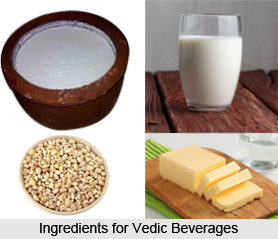 Beverages in Vedic Period formed a major part of Vedic cuisine. This included large variety of drinks which were prepared from the extracts of plants and fruits. These were treated as essential source of refreshment.
Beverages in Vedic Period formed a major part of Vedic cuisine. This included large variety of drinks which were prepared from the extracts of plants and fruits. These were treated as essential source of refreshment.
Beverages played a very significant role in ancient India. It mainly included two kinds of drinks. While the most important drink of Vedic Period is "Soma Ras" that was mentioned in the Vedic literature, the other type is the "Sura" which was highly condemnable. In Vedic period, drinks were used as a matter of celebration or even as a part of ritual.
Soma Ras of Vedic Period
In Vedic Period, lots of importance was given to Soma Juice which has been frequently referred as "Soma Ras" in various Vedic literatures. This drink is prepared from the extracts of a plant stalk that is collected from the mountain hills of Maujavanta.
The stalk before preparation is washed with water and then squeezed within two stones which squeeze the nectar. This nectar can be taken either as a drink directly or can be stored in jars and prepared with curd, clarified butter or milk to improve its taste. Overall, this drink is supposed to be very sweet and delicious in taste which has been considered as the major source of refreshment in Vedic period. This beverage was allowed to be taken as a part of celebration or a part of any ritual in which it was considered to be harmless both for man as well as society.
Sura of Vedic Period
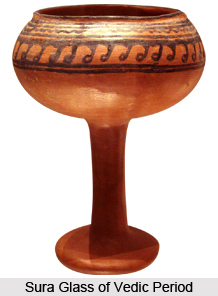 Beverages in Vedic Period along with Soma Ras included Sura which is a liquor prepared by fermenting barley or wild barley after distillation. A mention of Sura is visible in the Atharva Veda where it mentions Sura to be one of the items for sacrifice. The Vedic literature when mentions about the evil effects of taking liquor regards it as one of the 7 sins that is forbidden by the Vedas and classifies it with anger, senselessness and dicing. Because of its evil effect, the liquor has been prohibited by the Vedas for every Brahman who is supposed to live a virtuous life.
Beverages in Vedic Period along with Soma Ras included Sura which is a liquor prepared by fermenting barley or wild barley after distillation. A mention of Sura is visible in the Atharva Veda where it mentions Sura to be one of the items for sacrifice. The Vedic literature when mentions about the evil effects of taking liquor regards it as one of the 7 sins that is forbidden by the Vedas and classifies it with anger, senselessness and dicing. Because of its evil effect, the liquor has been prohibited by the Vedas for every Brahman who is supposed to live a virtuous life.
Other Drinks of Vedic Period
Beverages in Vedic period further include some more variety of drinks which are prepared from the extracts of the flowers or by fermenting some special kind of grasses. In general, the beverages of Vedic age were largely prepared by fermenting certain plant extracts or fruits which were re-mixed with more ingredients to have a better taste.
Along with Somarasa and Sura, the Vedic beverages also included "Parisutra" and "Kilala". While the former is prepared from flower extracts, the latter is prepared from cereals which are sweet in taste.
Yajur Veda further describes the preparation of another drink called "Masara" which was prepared from messing rice with some specific spices that was supposed to be fermented for 3 days and then filtered to extract the liquor.
Water has been described as nectar. The main source of water is from rivers, wells, springs and even rain water which can be used for drinking. Overall, these beverages formed a major part of Vedic Civilization in India.
Recipes in Vedic Period
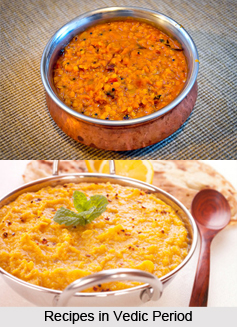 Indian recipes have been influenced by environmental, social, religious and political factors during the ancient period of Indian history. The recipes are as old as time, yet each recipe may have its own heritage and origin. In modern India, the history of Indian food mainly carried the traditional trends of Indian cuisines including the Hindu vegetarian food, Mughal delicacies, Chinese and other foreign delicacies.
Indian recipes have been influenced by environmental, social, religious and political factors during the ancient period of Indian history. The recipes are as old as time, yet each recipe may have its own heritage and origin. In modern India, the history of Indian food mainly carried the traditional trends of Indian cuisines including the Hindu vegetarian food, Mughal delicacies, Chinese and other foreign delicacies.
History of Indian Food
The history of Indian food can be traced back to the ancient days when the culture of preparing food with proper methods was introduced by the two ancient Indian civilizations - The Harappa and the Mohenjodaro. The first preparation of food included a number of cereals and pulses. Gradually, the ancient Indian civilization moved towards perfection. This was noticed during the Vedic period, which defined better forms of cooking with innovative recipes. In this period of time, a regular diet consisted of vegetables, fruits, grains, meat, honey, dairy products, beverages and special kind of spices.
Various Influences on Indian Cuisine
 The Aryans who traveled from Central Asia introduced a number of cuisines, which complemented the Vedic food culture. Food in ancient India further faced massive changes during the rule of Maurya and Gupta Empires. During these periods of time, the consumption of meat was strictly condemned due to sacred beliefs. Most of the people remained vegetarian due to the influence of religion.
The Aryans who traveled from Central Asia introduced a number of cuisines, which complemented the Vedic food culture. Food in ancient India further faced massive changes during the rule of Maurya and Gupta Empires. During these periods of time, the consumption of meat was strictly condemned due to sacred beliefs. Most of the people remained vegetarian due to the influence of religion.
During Medieval period, the food habits underwent changes with the introduction of the most popular Mughal cuisine by the Muslims from Central Asia. They brought various kinds of fruits and flat breads among Indians. Sumptuous dishes were prepared during the rule of Shah Jahan and Jahangir. Next, the Nizams and the Portuguese developed their own style of cooking with the notable dishes like Biryani and Indian Vindaloo dish respectively. Sweets became the major attraction not just during Indian festivals but also during special occasions.




















